Seat Belts
Toyota recommends that the driver and passengers in the vehicle be properly restrained at all times with the seat belts provided. Failure to do so could increase the chance of injury and/or the severity of injury in accidents.
- Child.
- We recommend that the child sit in the rear seat and be restrained with the seat belt. If sitting in the front, do not allow the child to stand up or kneel on the seat, and your child should be restrained by the seat belt.
- Baby or small child.
- Child restraint systems are available. We recommend the use of a type which fits your vehicle. Before installtion, always read the manufacturer's instruction.
- Pregnant woman.
- Toyota recommends the use of a seat belt. Ask your doctor for specific recommendations. The lap belt should be worn securely and as low as possible over the hips and not the waist.
- Injured person.
- Toyota recommends the use of a seat belt. Depending on the injury, however, first check with your doctor.
If seat belt regulations exist in the country where you reside, please contact your Toyota dealer for seat belt replacement or installtion.
| CAUTION: When using the seat belts, observe the following:
|
3-POINT TYPE
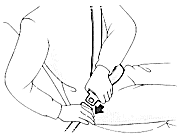 Adjust the seat as needed and sit up straight and well back in the seat. To fasten
your belt, pull it out of the retractor and insert it into the buckle.
Adjust the seat as needed and sit up straight and well back in the seat. To fasten
your belt, pull it out of the retractor and insert it into the buckle.
You will hear a click when the tab locks into the buckle.
The seat belt length automatically adjusts to your size and the seat position.
The retractor will lock the belt during a sudden stop or on impact. It also may lock if you lean forward too quickly. A slow, easy motion will allow the belt to extend, and you can move around freely.
If the seat belt can not be pulled out of the retractor, firmly pull the belt and release it. You will then be able to smoothly pull the belt out of the retractor.
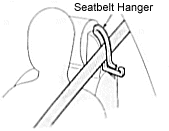 Seats with a seat belt hanger - Pass the shoulder belt through the seat belt hanger.
Seats with a seat belt hanger - Pass the shoulder belt through the seat belt hanger.
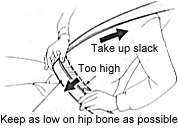 Adjust the position of the lap and shoulder belts.
Adjust the position of the lap and shoulder belts.Position the lap belt as low as possible on your hips - not on your waist, then adjust it to a snug fit by pulling the should portion upward through the latch plate.
CAUTION
|
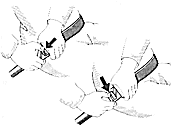 To release the belt, press the buckle-release button and allow the belt to retract.
To release the belt, press the buckle-release button and allow the belt to retract.On seats with a belt hanger, you need not remove the belt from the belt hanger except when the passengers get into or out of the rear seat.
If the belt does not retract smoothly, pull it out and check for kinksor twists. Then make sure that it remains untwisted as it retracts.
2-POINT TYPE
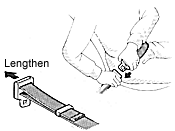 Sit up straight and well back in the seat. To fasten your belt, insert the tab into the buckle.
Sit up straight and well back in the seat. To fasten your belt, insert the tab into the buckle.
You will hear a click when the tab locks into the buckle.
If the belt is not long enough for you, hold the tab at a right angle to the belt and pull on the tab.
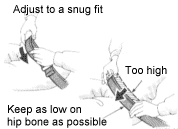 Remove excess length of the belt and adjust the belt position.
Remove excess length of the belt and adjust the belt position.
To shorten the belt, pull the free end of the belt.
Position the lap belt as low as possible on your hips - not your waist, then adjust it to a snug fit.
| CAUTION: High-positioned lap belts could increase the chance of injury due to sliding under the lap belt during an accident. |
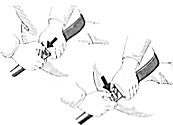 To release the belt, press the buckle-release button.
To release the belt, press the buckle-release button.